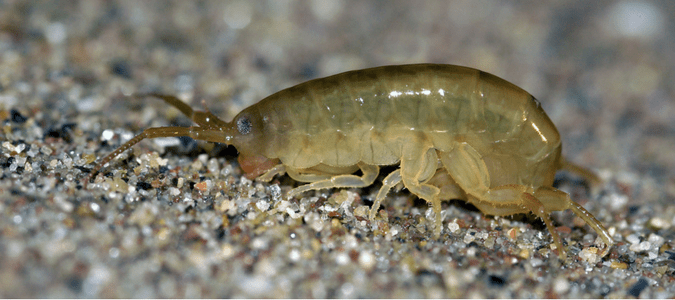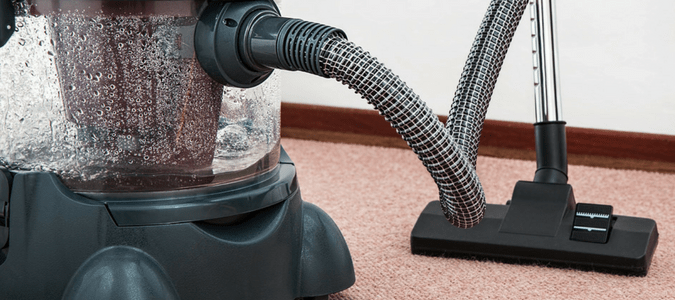
Many of us enjoy spending time in coastal areas, soaking up the sun at our favorite beach. While the feeling of the sand in our toes and the cool ocean breezes are welcome, there are some things about spending time near the water which aren’t as nice. One of the drawbacks is that we share the coastal environment with many other animals, some of which bite. One group of these creatures is commonly called sand fleas, which can leave behind irritating, itchy welts.
The next natural question you might ask as you are packing up to head home or to your hotel is “Can sand fleas travel home with you?”
The short answer to that question is that Americans typically don’t have true sand fleas in their homes. That’s because what we commonly call sand fleas in the United States and what are actually sand fleas, which are found in South America, the Caribbean and parts of Africa, are quite different. Sand fleas, also known as jigger fleas or by their scientific name, which is Tunga penetrans, are parasites which can cause a condition called tungiasis, which has been common in impoverished countries for centuries because of the lack of adequate medical care. Females burrow underneath victim’s skin, leaving a tiny opening at the skin’s surface to breathe, defecate and expel an egg-laden fluid.
Victims of tungiasis experience intense itching and infections which make walking difficult. While one sand flea is not a problem, victims can have hundreds of sand fleas on them at a time, especially since sand fleas tend to attract each other. Affected individuals often attempt to cut out the fleas on their own, which leads to other problems, especially when instruments haven’t been properly sterilized. If you think you have tungiasis, seek medical help, as a problem can be managed by surgically removing the parasites. So, technically, if you unknowingly bring a true sand flea home with you inside your body, it can travel home, but not in the way you’d expect, and not in a way that’s similar to bringing home bed bugs.
Now that we have talked about the worst possible outcome of an encounter with a sand flea, let’s talk about the creatures we most commonly encounter at the beach, whether you can get an infestation and how to keep these pets from bugging you.
What Are Sand Fleas, Exactly?
As we already mentioned, we typically call a group of animals sand fleas because their bites resemble flea bites, even though this is not usually what has bitten us. “Sand fleas” not only refers to insects that bite, including dog and cat fleas, gnats, flies and sand flies, but also to small crustaceans that live in coastal and marshy areas and are also known as beach hoppers, beach fleas and sand hoppers. The sand hopper is the creature pictured above.
These terrestrial crustaceans, like fleas that might bother our pets, are known for their ability to jump. Most of these animals stay protected in the sand during the day and emerge at night to feed on organic debris.
“Sand fly” is another loose term for flying insects we see in coastal areas. In tropical and subtropical areas and parts of Europe, infected female sand flies can transmit diseases such as Leishmaniasis, which can cause skin sore and impact internal organs. In some cases, when left untreated, the illness can have deadly consequences.
The insects we are most likely to run across on a trip to the beach are biting flies, midges and fleas. Black flies are sometimes also called “turkey gnats” and “buffalo gnats” because they tend to prey upon wildlife and livestock. These bloodsucking pests can also feed on humans, unfortunately. If you are bitten, you may experience symptoms of “black fly fever” which includes nausea, fever, headaches and swollen lymph nodes. The bite site can show a small puncture mark or swelling up to the size of a golf ball. In some equitorial countries in Africa and in mountainous parts of South and Central America, black flies can transmit river blindness.
In the United States, six species of black flies feed on humans. Other species may not bite, but can fly around our heads and crawl into our ears, making spending time outside annoying. In the Northeast and upper Midwest, black fly biting can become so bothersome during the late spring and early summer that hiking, kayaking and fishing can become unbearable.
Biting midges have a greater impact on livestock than humans, because they can spread the Blue Tongue virus. Midges are quite small, and their bites can leave behind a red welt and significant itching for those individuals who experience an allergic reaction. These insects are commonly known as “no see-ums” and are quite common along the Gulf Coast.

Can You Get A Sand Flea Infestation? How To Get Rid Of Fleas
Since the creatures we commonly call sand fleas are terrestrial crustaceans, they much prefer their beach habitat to our homes. Since we typically call any animal a sand flea that leaves us with bites similar to a dog or cat flea, the most common interventions for these creatures is the same as what would be recommended for a flea infestation.
The steps we recommend below will make your home less hospitable to fleas, as well as other unwelcome houseguests.
Thoroughly Clean Your Home
In general, fleas can be kept under control if you do a deep clean of the house, including vacuuming and washing sheets. Remember, these fleas tend to hide in areas that you may not expect. New homeowners should deep clean their homes before moving in furniture or pets. Keep in mind that anytime you take your pet to an area that might have fleas, whether it’s a beach, dog park or wooded area, your pet may introduce fleas into your lawn and home.
Steam Clean Your Floors
When we say that fleas hide in areas you may not expect, we mean areas like underneath carpeting, the cracks in your flooring, and so on. Because of this, sometimes it takes a localized steam cleaner to kill the bugs. Prolonged temperatures of 1030 degrees Fahrenheit can kill both adult fleas and larvae.
Take Precautions To Protect Your Yard
Even if you consistently clean your home, fleas may still make their way in from your yard–especially if your pet goes outside. Treating fleas in your yard can be done with chemical products or more organic options, including:
- Diatomaceous Earth
- Beneficial Nematodes
- Insecticides
These options all work differently to rid your home of fleas, with specific processes involved for each one and varying levels of risks for children and pets.

How To Get Rid Of Sand Fleas
If you want to avoid itching and scratching through your next beach outing, there are a few things you can do to keep these biting pests away, other than just avoiding the ocean entirely.
The most effective prevention against what we in the U.S. refer to as “sand fleas” is probably the least practical for a trip to the coast: put a barrier between you and these biting pests. Wearing pants, socks and closed toes shoes make it harder for these creatures to bite you.
Assuming that you have plans to work on your tan and go barefoot on the sand, many biting pests will avoid you if you apply a repellent with DEET as the active ingredient. Contrary to popular belief, these products protect you not only against mosquitoes, but also against ticks, fleas, no see-ums and other insects.
Some people recommend not visiting the beach right after it’s rained or in the cooler morning hours, as these conditions are more favorable for fleas and other biting insects. Others think sitting in a chair is preferable to lying on a beach towel, as it’s a bit harder for insects to find and feed on you.
If you are victim to bites at the beach, you can treat them much the same as you would treat a mosquito bite. Try to resist the urge to scratch, as this can lead to infection. Calamine lotion, specially-formulated sprays and cortisone creams can help with the itching, and ibuprofen can lessen swelling. Aloe vera and an oatmeal bath can also help with discomfort in severe cases.
Trust ABC to Handle Your Pest Problems
Some of these methods work on adult sand fleas, but will keep larvae intact, giving you only a minor break from sand flea bites. Your best bet is to call the experienced professionals at ABC Home & Commercial Services who can give you the best plan of action for getting rid of sand fleas and other pesky pests.
